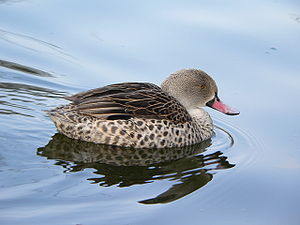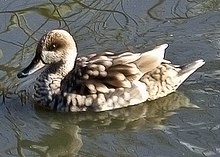Cape
| Cape | ||||||||||||
|---|---|---|---|---|---|---|---|---|---|---|---|---|

Cape duck ( Anas capensis ) |
||||||||||||
| Systematics | ||||||||||||
|
||||||||||||
| Scientific name | ||||||||||||
| Anas capensis | ||||||||||||
| Gmelin , 1789 |
The caped duck ( Anas capensis ), also known as the pale duck because of its light gray appearance , is a species from the genus of the real swimming duck . It is native to the Afrotropic wetlands . It is a species of duck that opportunistically moves with the rain. She undertakes long intra-African migrations.
Appearance
The duck's body length is between 44 and 46 centimeters. The capent is a small, compact duck. Because of its small size, its noticeably light plumage and its dark pink beak, it is almost unmistakable in its area of distribution. It swims relatively high on the water and can often be seen on land. Their green and white wing mirrors are clearly visible in flight . In the north of the distribution area it can overlap with the marbled duck. However, this is somewhat larger, is drawn dark in the eye region, has a gray beak and does not have a wing mirror.
As with many other Afrotropic ducks, there is no sexual dimorphism . The females are just a little smaller. Capents also do not exhibit seasonal dimorphism . The body plumage is pale brown-gray to silver-gray. The back is colored a little darker. The flanks are noticeably spotted. A pink beak is the distinguishing mark of adult birds. The beak is slightly concave upwards, the base of the beak is black. The iris is pale brown to orange-red. Legs and feet are dull yellow. Young ducks are similar to adult birds, but their plumage is somewhat dull overall. The beak is pale red with gray edges.
The chicks are gray-brown on the upper side of the body. The underside of the body is whitish. There are white spots on the wings and back. There is a white line around the beak. The face has a gray-brown stripe under the eyes. The beak is black-gray with reddish sides. The iris is dark brown and the feet are dark reddish gray.
Capents are generally not very reputation-friendly ducks. The male gets soft and nasal. The female croaks softly. During the breeding season, capents are a little more vocal. During this time, the male has a five-syllable call that falls in pitch.
distribution
The species is widespread in Africa. However, the distribution area is disjoint and can be divided into three parts.
A small population lives in the region around Lake Chad . Lake Chad is an inland lake with no outflow in West Africa . It is located on the southern edge of the Sahara in the region of Chad , Cameroon , Nigeria and Niger . The water level of this lake has dropped dramatically in recent years. The water balance of Lake Chad largely depends on the rainfall in the shared catchment area of the Schari and Logone rivers, some 800 km away . In the rhythm of the rainy seasons, the water level of the lake fluctuates and floods kilometers of flat land or retreats accordingly. With the shallow depth, in large areas of the lake, it is less than one meter, at the deepest points hardly more than five, and the high evaporation rate, which is generally assumed to be eight meters per year, is therefore constantly shifting its shoreline. The capent population around Lake Chad is believed to be nomadic. Odd guests from this region have already reached Israel.
The second population lives in the eastern rift of the Great Rift Valley . In Kenya , the rift is deepest in the north of Nairobi . Since there is no drain for the water here, the lakes formed are only shallow and have a high mineral content. Salt lakes and salt deposits are formed by evaporation of the water . For example, Lake Magadi is made up of soda ( sodium carbonate ), Lake Elmenteita , Lake Baringo , Lake Bogoria and Lake Nakuru are highly alkaline , and Lake Naivasha needs fresh water supplies to maintain its biodiversity. Populations occur in Ethiopia, Kenya, and Tanzania. The species is even common in places on the soda lakes in the Rift. The third population lives in southern Africa. It occurs in the Republic of South Africa, Namibia, Angola, Botswana and Zimbabwe.
The number of Kapents is not certain and the estimates sometimes vary widely. Conservative estimates assume a population of just over 33,500 individuals for southern Africa and less than 25,000 for the more northern populations. Other studies, from around the same period, assume 100,000 to 250,000 Capents for both the population in southern Africa and the north of this center.
Habitat and characteristic behavioral features
Capents prefer shallow waters. They are particularly common in brackish and salt water, on the soda lakes of the savannah, in salt pans, on lagoons, estuaries and swamp areas exposed to the tides. They mostly live in pairs or in small groups. Large swarms are rarely observed.
It is nomadic in parts of the distribution area and undertakes long hikes when the lakes it uses dry up. Ducks ringed at the Cape were found both in Namibia - around 1,850 kilometers further north - and in Mozambique - around 2,720 kilometers away. It is mostly crepuscular. It finds its food mainly rooting and being and mostly stays in the shallow water zone. But she also occasionally dives for her food.
The diet is omnivorous. The respective food composition depends on the food supply in their respective environment. If abundant, it can consist almost entirely of invertebrates and tadpoles. But it also eats small mollusks, which it sifts from the shallow water.
Reproduction
Capents are one of the species of duck for which bigamy has been proven. Couples stay together over several reproductive periods. The male does not defend the breeding area, but accompanies the female and also defends it.
The breeding period depends on the rainfall. When favorable conditions set in, capents are ready to breed very quickly. Clutches can be found in all months of the year. This also applies to the relatively cool South Africa. The dependence is attributed to the fact that the food supply is higher during and immediately after the rainy season.
The nest is built on the ground or in the floating vegetation. Nests that are not very carefully and poorly hidden are known for the species, as well as those that are well camouflaged and carefully laid out with dry stalks. Wherever they exist, capents prefer to breed on islands. The eggs are oval and have a smooth, light to cream-colored shell. The full clutch consists of five to eleven eggs. On average, a clutch has 8.2 eggs. The female breeds alone. The breeding season is 26 to 30 days. The male is actively involved in guiding the chicks. Capents therefore have a rearing rate that is slightly higher than that of other comparable species. The chicks can fledge after 42 to 56 days. Capents probably only raise one clutch per year.
Keeping in human care
Kapents were first imported to England in 1938. The world's first breeding took place in the same year at a British private owner. Capents are relatively often shown in zoos or taken care of by private owners. Keeping them is considered problem-free, even if this species of duck needs a shelter in Central Europe in winter.
Enclosed animals also have an inconsistent laying start in Central Europe. Here, too, it can be triggered by periods of rain.
swell
Single receipts
- ↑ a b Kear, p. 489.
- ↑ Kolbe, p. 196
- ↑ a b c d Kear, p. 490
- ↑ Kear, p. 490, the higher estimate is from 1997; the lower one from 2000
- ↑ a b c d e f g Kolbe, p. 197
- ^ Kear, p. 590
literature
- Janet Kear (Ed.): Ducks, Geese and Swans. Oxford University Press, 2005, ISBN 0-19-854645-9 .
- Hartmut Kolbe: The world's ducks. Ulmer Verlag 1999, ISBN 3-8001-7442-1 .
Web links
- Anas capensis onthe IUCN Red List of Threatened Species .
- Videos, photos and sound recordings on Anas capensis in the Internet Bird Collection

